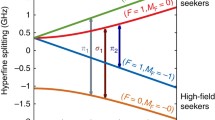Abstract
The aim of the ASACUSA-CUSP experiment at CERN is to produce a cold, polarised antihydrogen beam and perform a high precision measurement of the ground-state hyperfine transition frequency of the antihydrogen atom and compare it with that of the hydrogen atom using the same spectroscopic beam line. Towards this goal a significant step was successfully accomplished: synthesised antihydrogen atoms have been produced in a CUSP magnetic configuration and detected at the end of our spectrometer beam line in 2012 [1]. During a long shut down at CERN the ASACUSA-CUSP experiment had been renewed by introducing a new double-CUSP magnetic configuration and a new semi-cylindrical tracking detector (AMT) [2], and by improving the transport feature of low energy antiproton beams. The new tracking detector monitors the antihydrogen synthesis during the mixing cycle of antiprotons and positrons. In this work the latest results and improvements of the antihydrogen synthesis will be presented including highlights from the last beam time.
Similar content being viewed by others
References
Kuroda, N., et al.: Nat. Commun. 5, 3089 (2014)
Radics, B., et al.: Rev. Sci. Instrum. 86, 083304 (2015)
Radics, B., Murtagh, D.J., Yamazaki, Y., Robicheaux, F.: Phys. Rev. A 90, 032704 (2014)
Author information
Authors and Affiliations
Corresponding author
Additional information
This article is part of the Topical Collection on Proceedings of the 6th International Symposium on Symmetries in Subatomic Physics (SSP 2015), Victoria, Canada, 8-12 June 2015
Edited by Michael Gericke and Gerald Gwinner
Grant-in-Aid for Specially Promoted Research (No. 24000008) of the Japan Society for the Promotion of Science (JSPS), and Pioneering Project of RIKEN, European Research Council under European Union?s Seventh Framework Programme (FP7/2007-2013)/ERC Grant agreement (291242), the Austrian Ministry of Science and Research, Austrian Science Fund (FWF) DK PI (W 1252), Universit‘a di Brescia and Istituto Nazionale di Fisica Nucleare.
Rights and permissions
About this article
Cite this article
Radics, B., Ishikawa, S., Kuroda, N. et al. Antihydrogen synthesis in a double-CUSP trap towards test of the CPT-symmetry. Hyperfine Interact 237, 156 (2016). https://doi.org/10.1007/s10751-016-1368-4
Published:
DOI: https://doi.org/10.1007/s10751-016-1368-4



